Biodynamic agriculture is a kind of alternative farming that takes an ethical and ecological approach to gardening, farming, and food. Traditional farming, which comprises both organic and conventional farming methods, damages the quality of soil over time, with nutrient-draining vegetation, crops, and grazing livestock. Biodynamic farming provides a solution that helps create organic harmony and restore and maintain ecological balance in your garden or farm. This ensures that you make the most efficient use of the natural energy of your farm. Biodynamic agriculture is key if you want to practice sustainable, long-term farming. To be certified by the Demeter Association to practice biodynamic agriculture, a farm is required to meet certain guidelines, including greenhouse management, post-harvesting handling, processing procedures, and for livestock.
The origin of Biodynamic farming can be traced back to 1924 when several farmers started to raise concerns about soil degradation due to chemical fertilizers and constant use. At the time, Rudolph Steiner, an Austrian philosopher was teaching about anthroposophic agriculture that would later become known as biodynamic agriculture. In his lectures, Rudolph Steiner introduced his students to a spiritual philosophy known as anthroposophy or the study of man’s nature. These lectures are considered the first teaching on modern organic farming. Rudolph Steiner explored the link between land and the farmer, proclaiming that it was the responsibility of human beings to take care of their habitat, as well as its natural resources.
Rudolph Steiner created a large anthroposophic research/society group of about eight hundred members from across the world. Soon After, Erhard Bartsch, a German agronomist, led a team of biodynamic practitioners to investigate the impacts of biodynamic techniques on animal life, soil health, and plant quality. This further contributed to the development of biodynamic agriculture.
Biodynamic agricultural techniques and agricultural practices include meeting certain requirements for specific guidelines for annual and perennial planting, diverse crop rotation, use of green animal manure, use of cover crops, consideration of biological organisms (including livestock and organisms living in the soil), and avoiding the use of chemical fertilizers to help boost soil fertility. In biodynamic agriculture, a portion of the land is usually allocated for biodynamic practices such as biodiversity preservation (like planted insectaries and established wetlands to bring about ecological balance). In a nutshell, biodynamic agriculture fundamentally involves a spiritual focus that links land and human beings, with the main objective of creating a sustainable environment that will contribute to the betterment of humanity.

